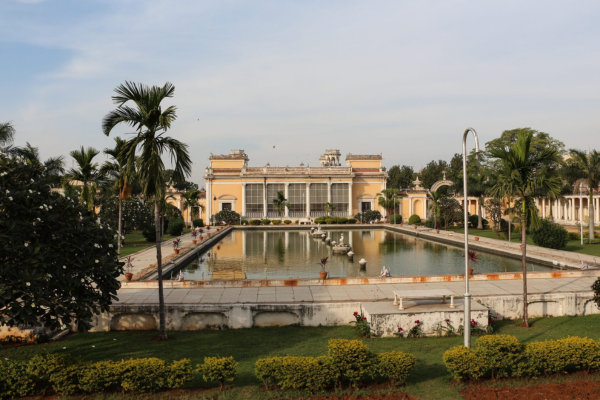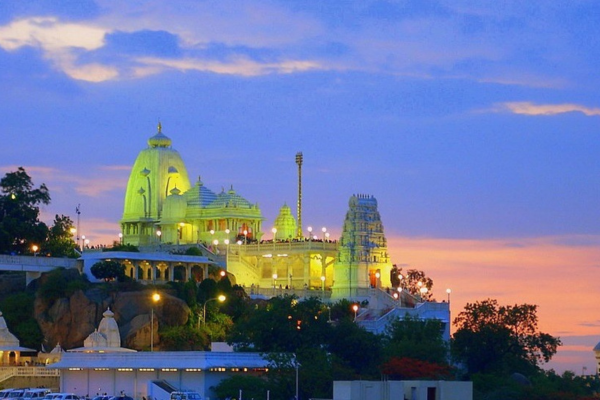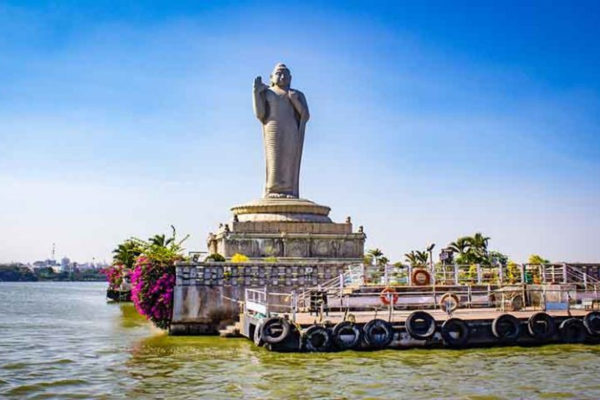Hyderabad, often called the “City of Pearls,” is a vibrant blend of rich heritage, royal history, and modern development. Tourists are drawn to its iconic landmarks such as the Charminar, Golconda Fort, and the magnificent Chowmahalla Palace, which reflect the grandeur of the Qutb Shahi and Nizam dynasties. The city’s unique culture is a fusion of Mughal, Persian, and South Indian influences, evident in its architecture, language, and traditions. Visitors can explore age-old bazaars like Laad Bazaar, renowned for bangles and pearls, or enjoy the serenity of Hussain Sagar Lake with its majestic Buddha statue.

The Charminar was constructed by Sultan Mohammed Quli Qutb Shah in 1591. This square-shaped monument, adorned with four grand pillars and intricate carvings, is believed to have been built in honor of his wife, Bhagmati. However, the true reason for its construction remains uncertain.
A widely accepted belief suggests that the Charminar was erected to commemorate the end of a devastating plague that had ravaged the city. According to this legend, Sultan Qutb Shah prayed for the cessation of the plague that had caused immense suffering among his people. Once the plague was eradicated, he built the Charminar as a tribute to Allah. The four pillars are also thought to represent the first four caliphs of Islam.

Golconda Fort, once the capital of the Qutub Shahi dynasty, is a remarkable historical site in India. The inner fort houses the ruins of palaces, mosques, and a hilltop pavilion that rises about 130 meters, offering stunning panoramic views of the surrounding area and the entire fort complex.
The fort’s strategic location and impressive architecture, with its massive gates and intricate carvings, reflect the grandeur of the Qutub Shahi rulers. Golconda Fort remains one of the most magnificent fortress complexes in India, attracting visitors with its rich history and architectural beauty.

The Qutub Shahi Tombs, a tentative UNESCO World Heritage site, hold immense historical significance in the context of Hyderabad’s rich past. Situated just 1 km from the iconic Golconda Fort, these tombs are located in Ibrahim Bagh, where the seven rulers of the Qutub Shahi dynasty are laid to rest.
The tombs, surrounded by the serene Ibrahim Bagh (garden precinct), feature both tombs and mosques commissioned by the kings of the Qutub Shahi dynasty. The smaller tombs are single-storied, while the larger ones are two-storied, showcasing impressive architectural style and grandeur.

Constructed from local granite, this mosque is one of the largest and most significant in India, and the largest in Hyderabad. Inspired by the Grand Mosque in Mecca, it spans 225 feet in length, 180 feet in width, and stands 75 feet tall. The mosque’s prayer hall is 67 meters long, 54 meters wide, and 23 meters high, supported by 15 arches.
It features two massive octagonal columns, each carved from a single granite piece, and is crowned by a dome. The mosque can accommodate 10,000 worshippers and is located just 200 yards from the Charminar. During construction, bricks were brought from Mecca, and a sacred relic of the Prophet is believed to be housed in a courtyard room.

Situated on the southern banks of the Musi River, the Salar Jung Museum is the third largest museum in India and is internationally recognized for its vast collection of antiques, the largest ever amassed by a single person. Nawab Mir Yousuf Ali Khan Salar Jung III, the former Prime Minister of the 7th Nizam of Hyderabad, spent over 35 years collecting these priceless artifacts, driven by his passion for preservation.
The collection was initially showcased in his Diwan Deodi palace before becoming a public museum in 1951, when it was inaugurated by Prime Minister Jawaharlal Nehru. In 1968, the museum was relocated to its present site at Afzalgunj. Today, it is overseen by a Board of Trustees, with the Governor of Telangana serving as the ex-officio chairperson under the Salar Jung Museum Act of 1961.

The history of Hyderabad unfolds like a captivating love story, with the Nizams’ reign at its core, leaving behind legendary contributions to art, architecture, and science. These achievements fill the pages of the city’s rich history, with the Chowmohalla Palace standing as one of the most remarkable symbols of their legacy.
Built between 1750 and 1869, the Chowmohalla Palace is an architectural masterpiece, named after the “four palaces” it houses. Modeled after the Shah’s Palace in Tehran, it showcases stunning Persian-inspired architecture. The palace consists of two courtyards, grand palaces, and the Durbar Hall (Khilwat), along with lush gardens and fountains, all of which reflect the grandeur and elegance of the Nizams’ royal heritage.

The Birla Mandir in Hyderabad offers a peaceful and serene atmosphere, making it an ideal retreat for those seeking to escape the hustle and bustle of city life and immerse themselves in prayer and meditation. This sacred temple is dedicated to Lord Venkateshwara of Tirumala and is modeled after the famous idol of Balaji in Tirupati.
Built in 1976 by Swami Renganathananda of the Ramakrishna Ashram and constructed by the Birla Foundation, the Birla Mandir has become a refuge for those looking to find tranquility amidst the city’s beauty. Perched atop a 280-foot-high hill called Naubat Pahad, the temple offers panoramic views of Hyderabad and Secunderabad, as well as the picturesque Hussain Sagar Lake. It is one of the best vantage points in the city, providing visitors with both spiritual solace and breathtaking scenery.

Ramoji Film City, recognized by the Guinness Book of World Records as the world’s largest film studio complex, has become a vibrant destination with its own distinct charm. Located 34 km from the heart of Hyderabad, it attracts millions of visitors who flock here to witness the magic of Tollywood movie sets and catch glimpses of film actors in action. Spanning over 1,500 acres, this vast film city is a blend of lush gardens, quirky statues, replicas of famous historical landmarks, open-air film sets, multi-cuisine restaurants, fast food joints, and trendy cafes.
You can easily spend an entire day exploring this cinematic wonderland, and even choose to stay in the luxurious 5-star and 7-star hotels within the complex. For an unforgettable experience, take a trip to the hilltop, offering stunning panoramic views of the entire film city. On your way back, make a stop at Pochampally, a group of villages renowned for their traditional Ikat weaving, where you can pick up some exquisite Hyderabad handloom souvenirs.

Hussain Sagar Lake, located just 2 km from the heart of Hyderabad, is one of the city’s most popular tourist attractions. This expansive artificial lake connects the twin cities of Hyderabad and Secunderabad. Excavated in 1562 AD during the reign of Ibrahim Quli Qutub Shah, it is the largest artificial lake in Asia. Originally created to meet the irrigation and water needs of the city, the lake served this purpose until 1930.
The lake is surrounded by Indira Park to the east, Sanjeevaiah Park to the north, and Lumbini Park to the south, offering a rare and scenic escape right in the city’s center. A bund built along its banks helps regulate the flow of water, adding both functionality and beauty to the area. In addition to its picturesque setting, Hussain Sagar holds historical significance as the site where the treaty between the Mughals and the Golconda Sultanate was signed, making it a culturally and historically important landmark.
Economy Cars

Premium Cars

Luxury Cars

Luxury Coaches

©2025 All Rights Reserved.




